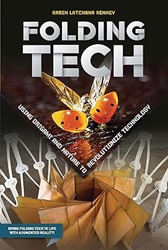
 Folding Tech
Folding TechUsing Origami and Nature to Revolutionize Technology
Twenty-First Century Books (Lerner), 2021. 104 pages.
Review written September 20, 2022, from a library book.
2023 Mathical Book Prize Honor Book, Ages 11 to 18
Starred Review
Here's a fascinating look at something I didn't even realize was mathematical -- origami. And the book explains how engineers and mathematicians studying origami have created some amazing and helpful technology.
The beginning talks about how there's not much room in a spacecraft, but a large area is what's needed for solar panels to power them. So in 1985, Koryo Miura proposed using an ancient folding pattern he'd studied to fit a solar array into a spacecraft. Japan launched such a craft in 1995.
Then the book talks about the long history of origami, particularly in Japan. But it's been revived in modern times, and studying it mathematically has helped create intricate and beautiful patterns. And then when stiff materials are used instead of paper, engineers can create foldable structures easy to assemble and inexpensive to create.
Engineers also find folding in nature. I was fascinated by the way they studied how ladybugs fold their wings under their elytra (the red and black shell on top). In order to get a good look, they 3D printed a clear plastic elytra and replaced the ladybug's own. Then they could see how the wings fold and unfold so quickly and neatly.
And there are so many uses for this technology! Besides outer space, there are even uses for tiny folds, including a foldable heart stent to go inside human arteries. There are also many uses in architecture and robots, and, really, the human imagination is the limit.
This book includes some origami designs the reader can try out. My one quibble is that I would have liked many more pictures. Some structures created using principles of origami were described in detail, and a picture would have helped visualize it. I read about a crushable beverage can with a diamond-shaped folding pattern and the Al Bahr Towers in Abu Dhabi that have a folding facade that changes shape in response to the sun. I would have liked to see pictures. Also, the James Webb telescope that made news recently as it began sending back photos of space did get a picture, but the only discussion of the folding that made that telescope possible was in the picture caption.
However, besides my little quibble (I just wanted more), this book is packed with fascinating information. My eyes are opened now, and I know I'm going to notice more folds, both in nature and in technology. A section at the end tells kids how they can pursue the path toward becoming an origami professional.
